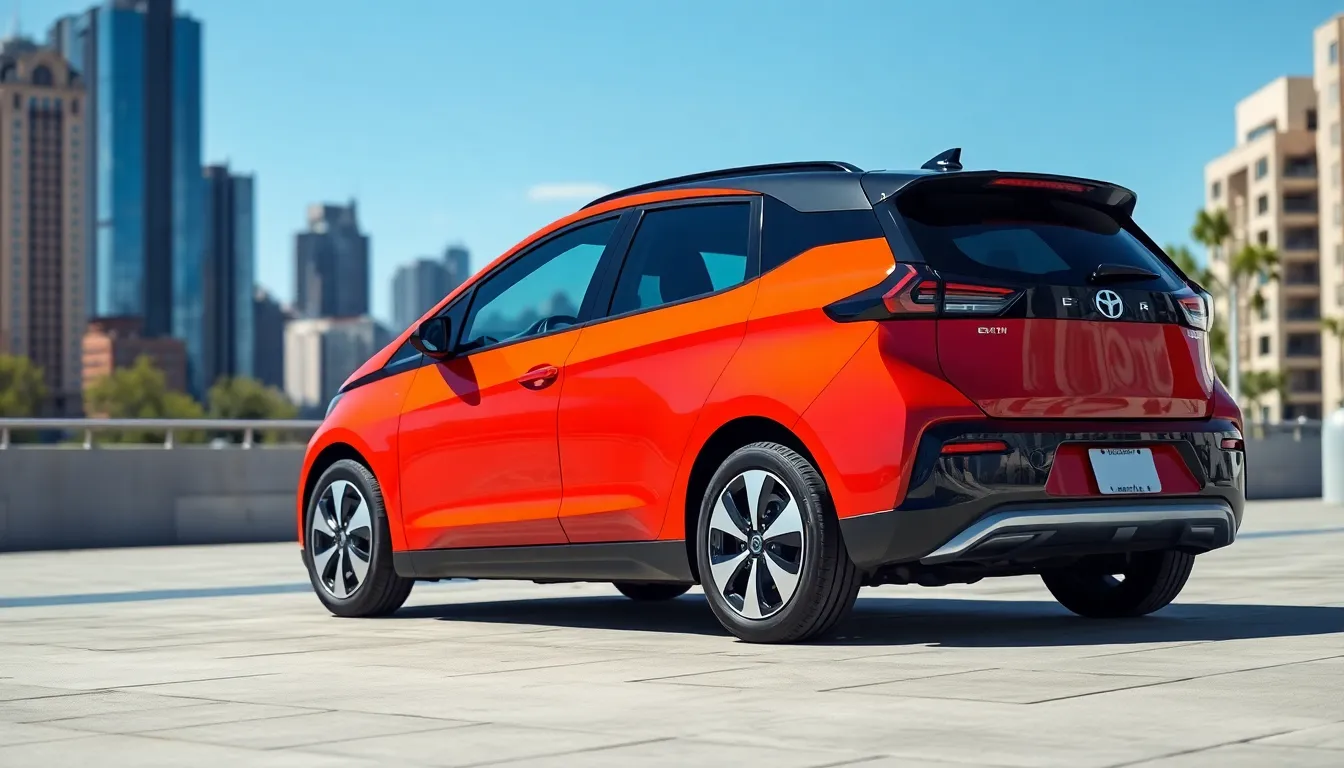The rise of electric vehicles (EVs) is transforming the way people think about transportation. With growing concerns over climate change and the need for sustainable energy solutions, more drivers are making the switch from traditional gasoline-powered cars to electric alternatives. This shift isn’t just a trend; it’s a movement toward a cleaner, greener future.
EVs offer numerous benefits, from reduced emissions to lower operating costs. As technology advances, these vehicles are becoming more accessible and efficient, making them an attractive option for a wider audience. Understanding the nuances of electric vehicles, including their impact on the environment and the economy, is crucial for anyone considering this innovative mode of transport.
Table of Contents
ToggleOverview of Electric Vehicles
Electric vehicles (EVs) are transforming the transportation landscape. These vehicles operate on electric power, primarily from batteries or fuel cells, providing an alternative to traditional internal combustion engines. Environmental benefits stand out, with EVs producing zero tailpipe emissions, thereby reducing air pollution and greenhouse gas emissions.
Several types of electric vehicles exist, including:
- Battery Electric Vehicles (BEVs): Fully powered by electricity, these vehicles rely solely on battery energy for operation.
- Plug-in Hybrid Electric Vehicles (PHEVs): Combining an electric propulsion system with a conventional internal combustion engine, PHEVs can switch between power sources to optimize efficiency.
- Fuel Cell Electric Vehicles (FCEVs): Utilizing hydrogen as a fuel source, FCEVs generate electricity through a chemical reaction, producing only water as a byproduct.
Advancements in battery technology contribute to increased driving ranges and faster charging times. For instance, modern EVs can achieve a range of over 300 miles on a single charge. Additionally, fast-charging stations can replenish batteries to approximately 80% in around 30 minutes, enhancing convenience for users.
Moreover, economic factors play a crucial role in EV adoption. Operating costs for electric vehicles typically remain lower compared to gasoline equivalents. The U.S. Department of Energy reports that electricity costs around half as much per mile as gasoline. Incentives, such as tax rebates and state-level subsidies, further facilitate the transition to electric options.
Understanding the overarching impact of electric vehicles on both the environment and economy strengthens the case for their adoption. With ongoing technological development, EVs continue to expand their presence in the automotive market, promoting a more sustainable future.
Benefits of Electric Vehicles

Electric vehicles (EVs) offer substantial benefits that contribute to a more sustainable future. These advantages encompass both environmental impact and economic savings.
Environmental Impact
EVs significantly reduce air pollution by producing zero tailpipe emissions. This reduction lowers the levels of harmful pollutants such as nitrogen oxides and particulate matter, improving urban air quality. According to the U.S. Environmental Protection Agency, switching from gasoline vehicles to EVs can lead to a decrease in greenhouse gas emissions, particularly if the electricity used for charging comes from renewable sources. Furthermore, the lifecycle emissions of EVs, from production to disposal, are generally lower than those of traditional vehicles, making them a more effective choice in combating climate change.
Economic Advantages
Operating costs for electric vehicles are notably lower than those of gasoline vehicles. The U.S. Department of Energy states that electricity generally costs about half as much per mile, providing substantial savings for drivers. Maintenance costs also decrease due to fewer moving parts and reduced wear on brake systems. Incentives available, such as federal tax credits and state-specific rebates, can significantly lower the initial purchase price. These financial benefits encourage a wider adoption of EVs, contributing to a more economically sustainable transportation model.
Types of Electric Vehicles
Electric vehicles come in various types, each designed to meet different needs and preferences. The main categories include Battery Electric Vehicles (BEVs), Plug-in Hybrid Electric Vehicles (PHEVs), and Fuel Cell Electric Vehicles (FCEVs).
Battery Electric Vehicles (BEVs)
Battery Electric Vehicles (BEVs) operate solely on electric power, relying entirely on rechargeable batteries. They produce zero tailpipe emissions, significantly reducing air pollutants. BEVs typically offer longer ranges, often exceeding 300 miles on a full charge. Models like the Tesla Model 3 and Chevrolet Bolt provide efficient energy consumption, maximizing the distance traveled. Charging options, including home charging units and widespread public charging stations, enhance convenience. With advancements in battery technology, BEVs now recharge to about 80% in around 30 minutes at fast-charging stations.
Plug-in Hybrid Electric Vehicles (PHEVs)
Plug-in Hybrid Electric Vehicles (PHEVs) combine an internal combustion engine with an electric motor, offering versatility in powering options. PHEVs can operate solely on electric power for shorter distances, typically between 20 and 50 miles, before transitioning to gasoline. This dual energy source provides flexibility for longer trips without range anxiety. Popular models like the Toyota Prius Prime and Ford Escape PHEV allow drivers to benefit from lower emissions and improved fuel efficiency. PHEVs also feature regenerative braking systems, further enhancing their energy efficiency by recovering kinetic energy while braking.
Challenges Facing Electric Vehicles
Despite the advantages of electric vehicles (EVs), several challenges hinder their widespread adoption. Key issues include infrastructure limitations and battery technology concerns.
Infrastructure Limitations
Infrastructure for electric vehicles significantly impacts their adoption process. Charging station availability plays a crucial role in the convenience and practicality of using EVs. As of 2023, over 100,000 public charging stations exist in the U.S., yet this number falls short compared to the extensive refueling network for gasoline vehicles. Rural and underserved areas often lack sufficient charging options, leading to “range anxiety” for potential EV owners. Accessibility and compatibility of charging stations also present challenges, as some locations may not offer fast-charging options or may require multiple forms of payment. Improved charging infrastructure, including more stations, faster charging capabilities, and enhanced support in less populated regions, remains vital for EV market growth.
Battery Technology Issues
Battery technology directly influences electric vehicle performance and adoption rates. Currently, most EVs utilize lithium-ion batteries, which can be expensive to manufacture and have limitations in energy density. Range and charging times are critical factors; while many modern EVs achieve over 300 miles on a single charge, others struggle to meet consumer expectations. Battery lifespan raises concerns too, as they generally last 8 to 15 years, with replacement costs averaging between $5,000 and $15,000. Recycling and sustainability also pose challenges, as the extraction of lithium and other materials can cause environmental harm. Innovations in battery technology, such as solid-state batteries and alternative materials, are essential to enhance performance, reduce costs, and improve environmental impacts, paving the way for broader EV acceptance.
Future of Electric Vehicles
The future of electric vehicles (EVs) appears promising, driven by ongoing advancements and supportive governmental frameworks. Industry experts anticipate significant growth in the adoption of EVs, resulting in transformative changes in transportation.
Trends and Innovations
Innovations in EV technology continue to enhance performance and accessibility. Key trends include:
- Battery Development: Solid-state batteries are emerging as a preferred alternative to lithium-ion batteries, offering greater energy density and faster charging times, thereby extending vehicle range.
- Autonomous Features: Many manufacturers are incorporating autonomous driving functionalities in EV models, increasing safety and convenience for users.
- Smart Charging Solutions: Intelligent charging stations that optimize energy usage during peak and off-peak hours are gaining traction, enhancing efficiency and reducing costs for drivers.
- Vehicle-to-Grid Technology: This innovative solution enables EVs to feed energy back into the grid, supporting energy management and providing additional income streams for EV owners.
These trends indicate a shift towards smarter, more sustainable transportation networks.
Policy and Regulation
Government policies and regulations significantly influence the EV landscape. Key points include:
- Incentives: Federal and state-level tax credits, rebates, and grants encourage consumers to choose EVs, facilitating broader adoption.
- Emission Standards: Stricter emission regulations drive manufacturers toward electric options, significantly reducing air pollution.
- Infrastructure Investment: Increased funding for charging infrastructure development, particularly in underserved areas, addresses range anxiety and promotes EV usage.
- International Agreements: Countries aiming to meet climate goals are setting electrification targets, urging manufacturers to accelerate their EV offerings.
Policy frameworks align with technological advancements to foster a robust future for electric vehicles.
The transition to electric vehicles is more than just a trend; it’s a pivotal movement towards a sustainable future. As technology advances and infrastructure improves, the barriers to EV adoption are gradually diminishing. With significant environmental benefits and economic incentives, consumers are increasingly recognizing the value of making the switch.
Innovations like solid-state batteries and smart charging solutions promise to enhance the EV experience further. The collaborative efforts of governments and industries will undoubtedly shape a more efficient and environmentally friendly transportation landscape. Embracing electric vehicles today can lead to a cleaner tomorrow, making it an exciting time for both consumers and the planet.
